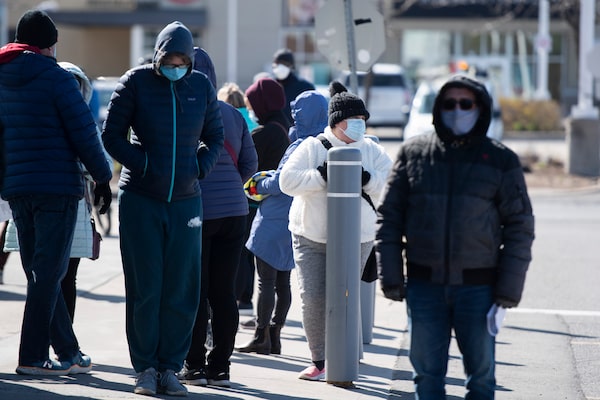
People wait in a line to receive a COVID-19 vaccine at a Loblaws grocery store pharmacy in Ottawa, on April 26, 2021.Justin Tang/The Canadian Press
Fahad Razak, Arthur Slutsky and David Naylor are physicians and professors in the department of medicine at the University of Toronto.
As the third wave of the COVID-19 pandemic continues, one question recurs for many Canadians: How can we reduce its intensity, duration and impact – and crucially, how do we speed our return to some semblance of normal life?
The most successful jurisdictions have adopted an intense suppression-based strategy. Examples of this COVID-zero approach include Taiwan, Australia and notably our own Atlantic bubble. Alas, for much of Canada, that ship has sailed.
Casting about for more feasible examples, it is clear that each country has experienced its own pattern, time course, emergence of variants, and sociodemographic distribution of COVID-19 infections. There are also important differences in vaccine access and deployment strategies.
How Doug Ford and Justin Trudeau can create a paid sick leave program that actually works
We’re getting COVID-19 shots. Now, find the willing arms
All things considered, we believe Britain’s agile and effective response to its most recent COVID-19 surge represents the best example for Canadians in this dark hour.
What are the parallels between the countries? First, Britain’s winter surge was driven by COVID-19 variant B.1.1.7. First observed in Britain, this highly infectious strain of the virus is very prominent in several Canadian provinces.
Second, Britain has a diverse population and, like Canada, has seen a disproportionate burden of COVID-19 on essential workers, and on lower-income and racialized groups.
Third, Canada has adopted a “first doses fast” vaccine strategy, patterned closely on the British approach as we race to give as many people as possible some level of immunity.
Fourth, Britain relied heavily on AstraZeneca and Pfizer for its vaccination campaign. Canada is using both vaccines along with Moderna and, in short order, Johnson & Johnson. Fortunately, they are all reasonably effective against the current variants.
But here is the hard part. Along with vaccines, Britain’s success owes to very strict public-health measures. Recent examples such as the catastrophe in Michigan are a further reminder that vaccines alone are insufficient.
How strict were Britain’s lockdowns? They were familiar in form, but somewhat tougher than anything applied in Canada, according to an Oxford University Stringency Index. These measures included complete school, college and university closings with few exceptions. People were only allowed to leave home for essential work, food and medicine. All non-essential retail outlets were closed, restaurants were limited to takeaway, and outdoor exercise was limited to once a day.
These extreme measures were mounted in response to a terrifying post-Christmas eruption in Britain. The seven-day running average of new COVID-19 cases peaked on Jan. 9 at well above three times our current rate. This seems unthinkable, not least in Ontario, where hospitals and intensive-care units are being overwhelmed.
A near-miracle then occurred as the impact of tough public-health measures and the rapid vaccine rollout took hold. Two weeks past peak, cases had dropped to about 60 per cent of the peak level, and two weeks later were just above 30 per cent. Today on a per capita basis, the running average of new cases in Britain is about one sixth of the Canadian rate. Precautionary measures are still in force, but society has begun opening up. Children are in school and people are once again going to pubs and hair salons.
Can we follow the British model to achieve a Canada Day miracle?
Yes, we can. The aim must be to cover 80 per cent of our adult population (16 years and older) with a first vaccine dose, and provide a timely second dose for those who are immunocompromised or over 70. If Canada averages 400,000 jabs a day over the next 10 weeks, we’ll be done early. Recent daily doses have exceeded 300,000, and there’s documented room to go above 400,000 doses a day. Enough federal-provincial squabbling. Get the doses and get it done.
The public-health measures that the British took were severe, but many have already been implemented by some provinces. All are needed, with arguably one exception. We can take advantage of spring weather to decompress the lockdown with more time outdoors than Britain allowed. Given remarkable past compliance by Canadians, similar successes seem possible here if our governments will take all the requisite steps to support Canadians through this hardship.
In short, if Canadians can sustain strict public-health measures for a number of weeks, and if vaccination rates can be moderately increased, we should be able to put the worst behind us. The way forward is clear, and both the example of the U.K. and our own federal modelling tell us this is eminently achievable. Let’s take the steps needed, so that by July 1, we can celebrate Canada Day, rather than another miserable COVID day.
Keep your Opinions sharp and informed. Get the Opinion newsletter. Sign up today.